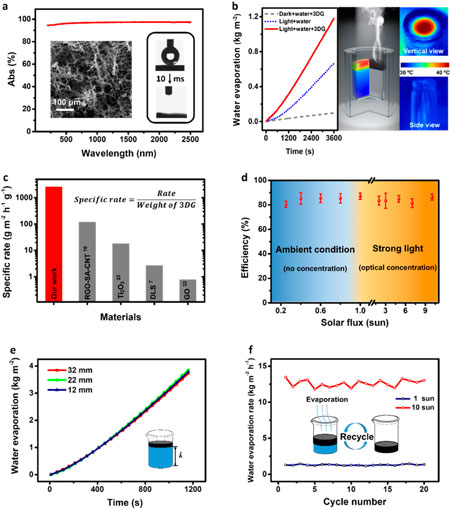| Posted: Jan 10, 2018 | |
Graphene foam can act as efficient solar thermal capture and conversion device(Nanowerk News) Researchers have demonstrated that a simple sheet of standalone graphene foam can act as efficient solar thermal capture and conversion device. |
|
| As reported in ACS Nano ("Graphene-Based Standalone Solar Energy Converter for Water Desalination and Purification"), the 3D cross-linked polymer-like graphene material (3DG) material can be used directly in an easy and scalable manner as a clean water generator with high efficiency under normal and even weaker sunlight (down to 0.25 sun). | |
| The new 3DG material has an extremely high specific water production rate of 2.6 kg h-1 m-2 g-1 and 87% energy efficiency under 1 sun solar radiation. | |
 |
|
| Solar thermal performance of the 3D graphene material. (a) Absorption spectrum of 3DG. It shows a blackbody-like property with ~97% absorption across 200-2500 nm. Left part of the inset is the SEM image showing its porous morphology. Such morphology benefits from efficient light absorption through the multiscattering effect and water transportation through the interconnected pores. Right part of the inset is the contact angle showing it is superhydrophilic. (b) Left is the evaporation mass of water with/without 3DG under 1 kW m-2 solar irradiation and the case without light; the middle is the schematic illustration of 3DG for the vapor generation and the temperature distribution (cross section); the right part is the IR image of vertical and side view under 1 kW m-2. The sample is smaller than the water/air interface to show that such a material can effectively prevent the heat conduction surrounding water. (c) Specific water production rate (water production rate/weight of 3DG) compared with some highest performing bulk converters reported in literature. (d) Solar thermal efficiency of the evaporation process by the 3DG under a range of optical concentrations. Error bars represent standard deviation for the same repeated measurements. (e) Performance of the 3DG with different water quantities under 10 kW m-2. The device was in the same diameter but different heights of water at 32 mm (red), 22 mm (green), and 12 mm (blue). (f) Reusability of 3DG under 1 and 10 kW m-2 solar irradiation for 20 cycles with a NaCl solution, mimicking the seawater. Each cycle was tested for 2 h. (© American Chemical Society) (click on image to enlarge) | |
| The researchers point out that the high efficiency is achieved due to the combination of multiple properties simultaneously exhibited by this as-prepared bulk 3D crosslinked honeycomb graphene material, including its intrinsic blackbody-like high absorption, extremely low thermal loss to environment, hydrophilicity, and automatic water transportation to the absorber by capillary force through the microchannels present in the structure. | |
| With these results, an efficient and scalable desalination (4 orders of salinity decrement) and sewage treatment device was demonstrated. A model for this converter has been used to understand the high efficiency and mechanism. | |
| Furthermore, different from other desalination materials, this novel lightweight and elastic material is also highly portable for point of use and would be ideal for both personal and industrial application. | |
| "This easy-to-use carbon material could provide many possibilities for high efficient solar energy harvesting," the authors conclude. |
 By
Michael
Berger
– Michael is author of three books by the Royal Society of Chemistry:
Nano-Society: Pushing the Boundaries of Technology,
Nanotechnology: The Future is Tiny, and
Nanoengineering: The Skills and Tools Making Technology Invisible
Copyright ©
Nanowerk LLC
By
Michael
Berger
– Michael is author of three books by the Royal Society of Chemistry:
Nano-Society: Pushing the Boundaries of Technology,
Nanotechnology: The Future is Tiny, and
Nanoengineering: The Skills and Tools Making Technology Invisible
Copyright ©
Nanowerk LLC
|
|
|
Subscribe to a free copy of one of our daily Nanowerk Newsletter Email Digests with a compilation of all of the day's news. |
